ICMS TOU 240 - Innovation Product Report: Wotif's Real-Time Pricing
VerifiedAdded on 2023/06/03
|10
|2944
|173
Report
AI Summary
This report analyzes Wotif's innovative real-time pricing strategy and its impact on the tourism and hospitality industry. It begins by providing background information on Wotif and its product review, highlighting its real-time online price management. The report then examines the product develop...

Innovation Product Report
Paraphrase This Document
Need a fresh take? Get an instant paraphrase of this document with our AI Paraphraser
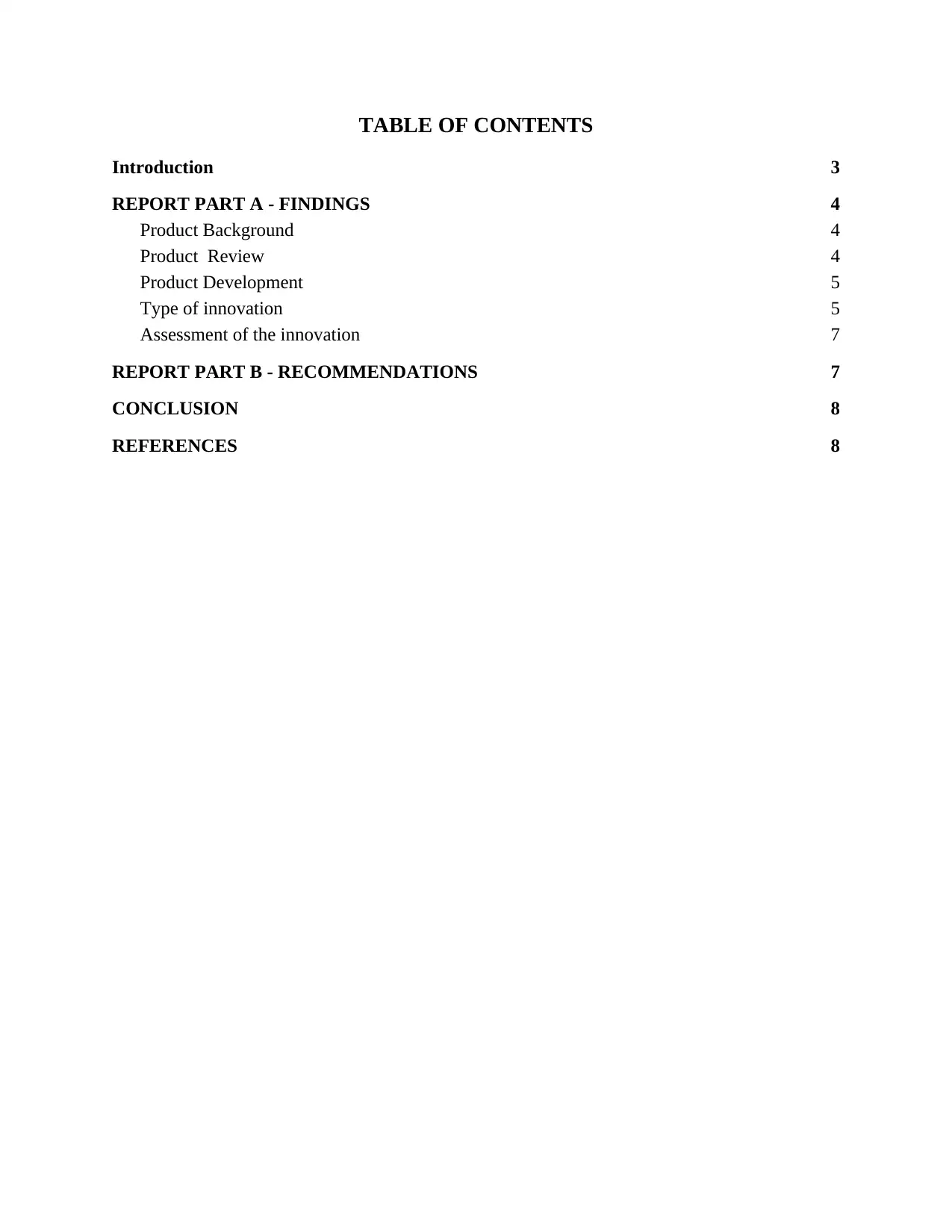
TABLE OF CONTENTS
Introduction 3
REPORT PART A - FINDINGS 4
Product Background 4
Product Review 4
Product Development 5
Type of innovation 5
Assessment of the innovation 7
REPORT PART B - RECOMMENDATIONS 7
CONCLUSION 8
REFERENCES 8
Introduction 3
REPORT PART A - FINDINGS 4
Product Background 4
Product Review 4
Product Development 5
Type of innovation 5
Assessment of the innovation 7
REPORT PART B - RECOMMENDATIONS 7
CONCLUSION 8
REFERENCES 8
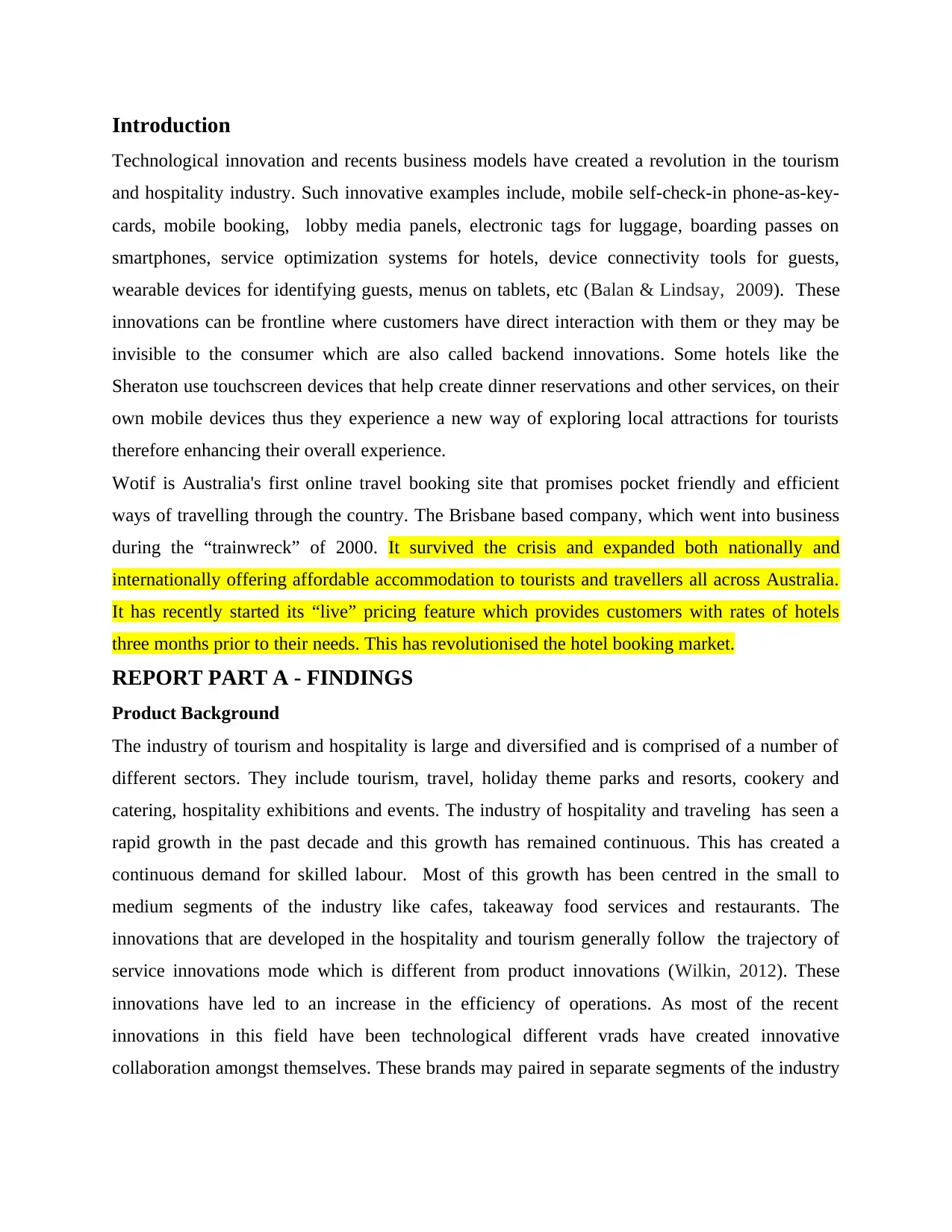
Introduction
Technological innovation and recents business models have created a revolution in the tourism
and hospitality industry. Such innovative examples include, mobile self-check-in phone-as-key-
cards, mobile booking, lobby media panels, electronic tags for luggage, boarding passes on
smartphones, service optimization systems for hotels, device connectivity tools for guests,
wearable devices for identifying guests, menus on tablets, etc (Balan & Lindsay, 2009). These
innovations can be frontline where customers have direct interaction with them or they may be
invisible to the consumer which are also called backend innovations. Some hotels like the
Sheraton use touchscreen devices that help create dinner reservations and other services, on their
own mobile devices thus they experience a new way of exploring local attractions for tourists
therefore enhancing their overall experience.
Wotif is Australia's first online travel booking site that promises pocket friendly and efficient
ways of travelling through the country. The Brisbane based company, which went into business
during the “trainwreck” of 2000. It survived the crisis and expanded both nationally and
internationally offering affordable accommodation to tourists and travellers all across Australia.
It has recently started its “live” pricing feature which provides customers with rates of hotels
three months prior to their needs. This has revolutionised the hotel booking market.
REPORT PART A - FINDINGS
Product Background
The industry of tourism and hospitality is large and diversified and is comprised of a number of
different sectors. They include tourism, travel, holiday theme parks and resorts, cookery and
catering, hospitality exhibitions and events. The industry of hospitality and traveling has seen a
rapid growth in the past decade and this growth has remained continuous. This has created a
continuous demand for skilled labour. Most of this growth has been centred in the small to
medium segments of the industry like cafes, takeaway food services and restaurants. The
innovations that are developed in the hospitality and tourism generally follow the trajectory of
service innovations mode which is different from product innovations (Wilkin, 2012). These
innovations have led to an increase in the efficiency of operations. As most of the recent
innovations in this field have been technological different vrads have created innovative
collaboration amongst themselves. These brands may paired in separate segments of the industry
Technological innovation and recents business models have created a revolution in the tourism
and hospitality industry. Such innovative examples include, mobile self-check-in phone-as-key-
cards, mobile booking, lobby media panels, electronic tags for luggage, boarding passes on
smartphones, service optimization systems for hotels, device connectivity tools for guests,
wearable devices for identifying guests, menus on tablets, etc (Balan & Lindsay, 2009). These
innovations can be frontline where customers have direct interaction with them or they may be
invisible to the consumer which are also called backend innovations. Some hotels like the
Sheraton use touchscreen devices that help create dinner reservations and other services, on their
own mobile devices thus they experience a new way of exploring local attractions for tourists
therefore enhancing their overall experience.
Wotif is Australia's first online travel booking site that promises pocket friendly and efficient
ways of travelling through the country. The Brisbane based company, which went into business
during the “trainwreck” of 2000. It survived the crisis and expanded both nationally and
internationally offering affordable accommodation to tourists and travellers all across Australia.
It has recently started its “live” pricing feature which provides customers with rates of hotels
three months prior to their needs. This has revolutionised the hotel booking market.
REPORT PART A - FINDINGS
Product Background
The industry of tourism and hospitality is large and diversified and is comprised of a number of
different sectors. They include tourism, travel, holiday theme parks and resorts, cookery and
catering, hospitality exhibitions and events. The industry of hospitality and traveling has seen a
rapid growth in the past decade and this growth has remained continuous. This has created a
continuous demand for skilled labour. Most of this growth has been centred in the small to
medium segments of the industry like cafes, takeaway food services and restaurants. The
innovations that are developed in the hospitality and tourism generally follow the trajectory of
service innovations mode which is different from product innovations (Wilkin, 2012). These
innovations have led to an increase in the efficiency of operations. As most of the recent
innovations in this field have been technological different vrads have created innovative
collaboration amongst themselves. These brands may paired in separate segments of the industry
⊘ This is a preview!⊘
Do you want full access?
Subscribe today to unlock all pages.

Trusted by 1+ million students worldwide
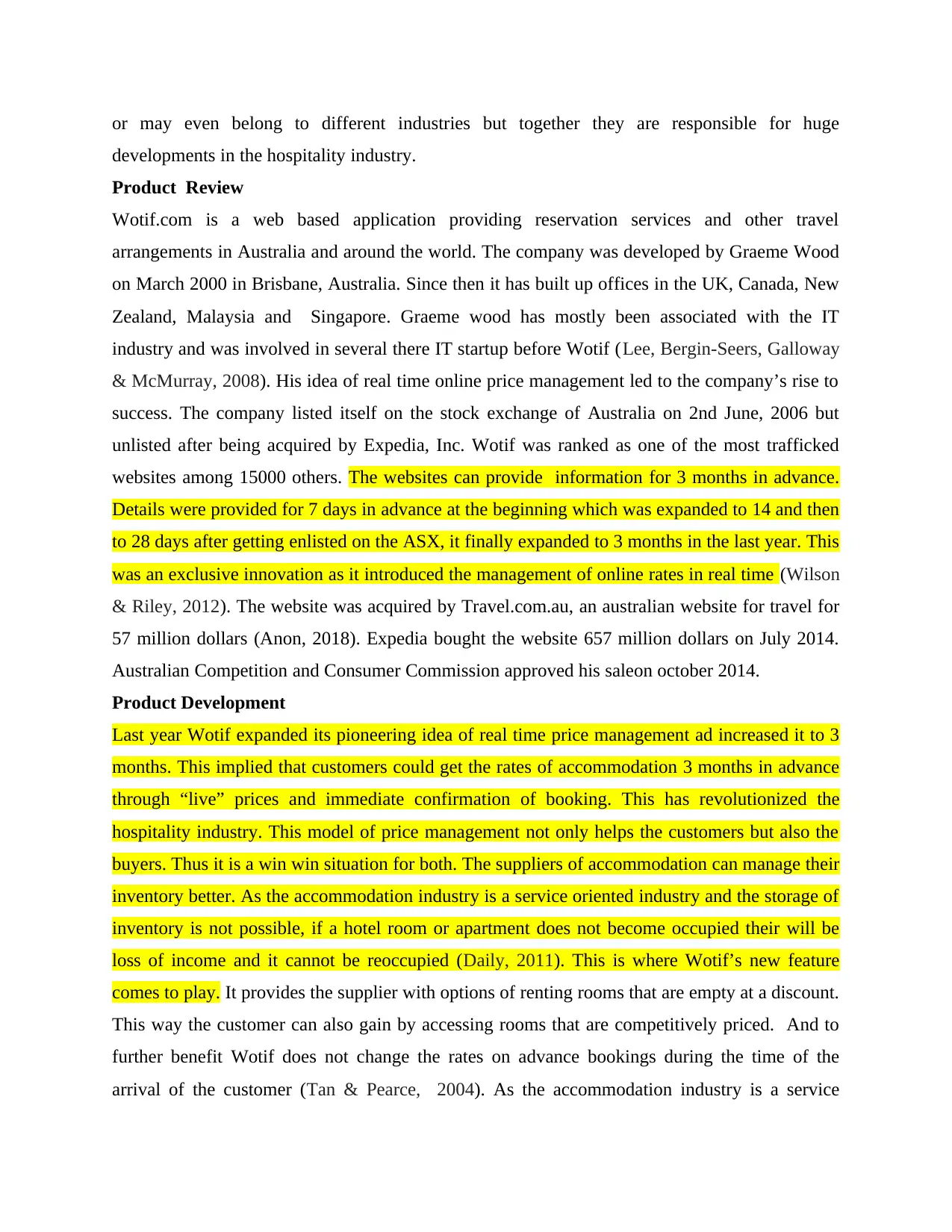
or may even belong to different industries but together they are responsible for huge
developments in the hospitality industry.
Product Review
Wotif.com is a web based application providing reservation services and other travel
arrangements in Australia and around the world. The company was developed by Graeme Wood
on March 2000 in Brisbane, Australia. Since then it has built up offices in the UK, Canada, New
Zealand, Malaysia and Singapore. Graeme wood has mostly been associated with the IT
industry and was involved in several there IT startup before Wotif (Lee, Bergin-Seers, Galloway
& McMurray, 2008). His idea of real time online price management led to the company’s rise to
success. The company listed itself on the stock exchange of Australia on 2nd June, 2006 but
unlisted after being acquired by Expedia, Inc. Wotif was ranked as one of the most trafficked
websites among 15000 others. The websites can provide information for 3 months in advance.
Details were provided for 7 days in advance at the beginning which was expanded to 14 and then
to 28 days after getting enlisted on the ASX, it finally expanded to 3 months in the last year. This
was an exclusive innovation as it introduced the management of online rates in real time (Wilson
& Riley, 2012). The website was acquired by Travel.com.au, an australian website for travel for
57 million dollars (Anon, 2018). Expedia bought the website 657 million dollars on July 2014.
Australian Competition and Consumer Commission approved his saleon october 2014.
Product Development
Last year Wotif expanded its pioneering idea of real time price management ad increased it to 3
months. This implied that customers could get the rates of accommodation 3 months in advance
through “live” prices and immediate confirmation of booking. This has revolutionized the
hospitality industry. This model of price management not only helps the customers but also the
buyers. Thus it is a win win situation for both. The suppliers of accommodation can manage their
inventory better. As the accommodation industry is a service oriented industry and the storage of
inventory is not possible, if a hotel room or apartment does not become occupied their will be
loss of income and it cannot be reoccupied (Daily, 2011). This is where Wotif’s new feature
comes to play. It provides the supplier with options of renting rooms that are empty at a discount.
This way the customer can also gain by accessing rooms that are competitively priced. And to
further benefit Wotif does not change the rates on advance bookings during the time of the
arrival of the customer (Tan & Pearce, 2004). As the accommodation industry is a service
developments in the hospitality industry.
Product Review
Wotif.com is a web based application providing reservation services and other travel
arrangements in Australia and around the world. The company was developed by Graeme Wood
on March 2000 in Brisbane, Australia. Since then it has built up offices in the UK, Canada, New
Zealand, Malaysia and Singapore. Graeme wood has mostly been associated with the IT
industry and was involved in several there IT startup before Wotif (Lee, Bergin-Seers, Galloway
& McMurray, 2008). His idea of real time online price management led to the company’s rise to
success. The company listed itself on the stock exchange of Australia on 2nd June, 2006 but
unlisted after being acquired by Expedia, Inc. Wotif was ranked as one of the most trafficked
websites among 15000 others. The websites can provide information for 3 months in advance.
Details were provided for 7 days in advance at the beginning which was expanded to 14 and then
to 28 days after getting enlisted on the ASX, it finally expanded to 3 months in the last year. This
was an exclusive innovation as it introduced the management of online rates in real time (Wilson
& Riley, 2012). The website was acquired by Travel.com.au, an australian website for travel for
57 million dollars (Anon, 2018). Expedia bought the website 657 million dollars on July 2014.
Australian Competition and Consumer Commission approved his saleon october 2014.
Product Development
Last year Wotif expanded its pioneering idea of real time price management ad increased it to 3
months. This implied that customers could get the rates of accommodation 3 months in advance
through “live” prices and immediate confirmation of booking. This has revolutionized the
hospitality industry. This model of price management not only helps the customers but also the
buyers. Thus it is a win win situation for both. The suppliers of accommodation can manage their
inventory better. As the accommodation industry is a service oriented industry and the storage of
inventory is not possible, if a hotel room or apartment does not become occupied their will be
loss of income and it cannot be reoccupied (Daily, 2011). This is where Wotif’s new feature
comes to play. It provides the supplier with options of renting rooms that are empty at a discount.
This way the customer can also gain by accessing rooms that are competitively priced. And to
further benefit Wotif does not change the rates on advance bookings during the time of the
arrival of the customer (Tan & Pearce, 2004). As the accommodation industry is a service
Paraphrase This Document
Need a fresh take? Get an instant paraphrase of this document with our AI Paraphraser
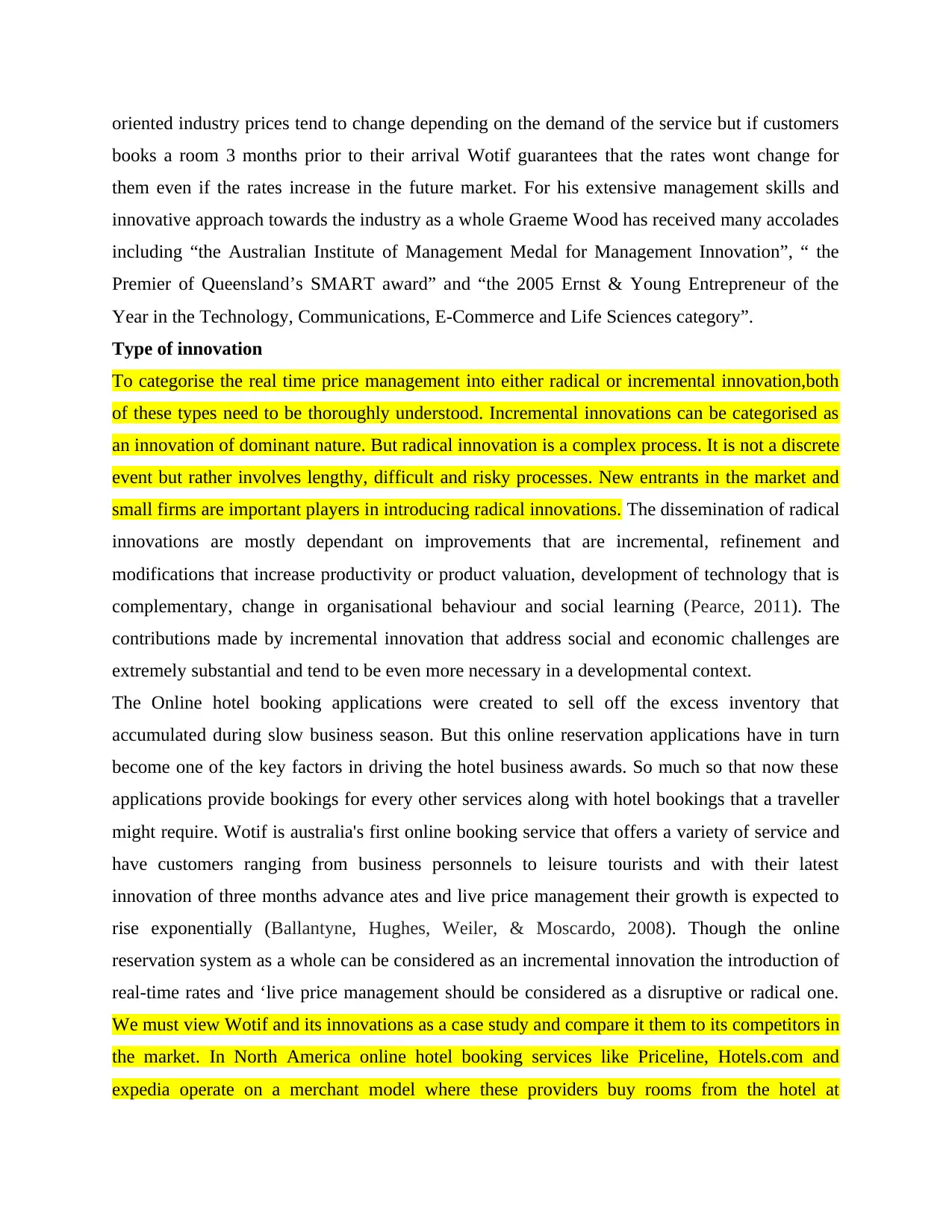
oriented industry prices tend to change depending on the demand of the service but if customers
books a room 3 months prior to their arrival Wotif guarantees that the rates wont change for
them even if the rates increase in the future market. For his extensive management skills and
innovative approach towards the industry as a whole Graeme Wood has received many accolades
including “the Australian Institute of Management Medal for Management Innovation”, “ the
Premier of Queensland’s SMART award” and “the 2005 Ernst & Young Entrepreneur of the
Year in the Technology, Communications, E-Commerce and Life Sciences category”.
Type of innovation
To categorise the real time price management into either radical or incremental innovation,both
of these types need to be thoroughly understood. Incremental innovations can be categorised as
an innovation of dominant nature. But radical innovation is a complex process. It is not a discrete
event but rather involves lengthy, difficult and risky processes. New entrants in the market and
small firms are important players in introducing radical innovations. The dissemination of radical
innovations are mostly dependant on improvements that are incremental, refinement and
modifications that increase productivity or product valuation, development of technology that is
complementary, change in organisational behaviour and social learning (Pearce, 2011). The
contributions made by incremental innovation that address social and economic challenges are
extremely substantial and tend to be even more necessary in a developmental context.
The Online hotel booking applications were created to sell off the excess inventory that
accumulated during slow business season. But this online reservation applications have in turn
become one of the key factors in driving the hotel business awards. So much so that now these
applications provide bookings for every other services along with hotel bookings that a traveller
might require. Wotif is australia's first online booking service that offers a variety of service and
have customers ranging from business personnels to leisure tourists and with their latest
innovation of three months advance ates and live price management their growth is expected to
rise exponentially (Ballantyne, Hughes, Weiler, & Moscardo, 2008). Though the online
reservation system as a whole can be considered as an incremental innovation the introduction of
real-time rates and ‘live price management should be considered as a disruptive or radical one.
We must view Wotif and its innovations as a case study and compare it them to its competitors in
the market. In North America online hotel booking services like Priceline, Hotels.com and
expedia operate on a merchant model where these providers buy rooms from the hotel at
books a room 3 months prior to their arrival Wotif guarantees that the rates wont change for
them even if the rates increase in the future market. For his extensive management skills and
innovative approach towards the industry as a whole Graeme Wood has received many accolades
including “the Australian Institute of Management Medal for Management Innovation”, “ the
Premier of Queensland’s SMART award” and “the 2005 Ernst & Young Entrepreneur of the
Year in the Technology, Communications, E-Commerce and Life Sciences category”.
Type of innovation
To categorise the real time price management into either radical or incremental innovation,both
of these types need to be thoroughly understood. Incremental innovations can be categorised as
an innovation of dominant nature. But radical innovation is a complex process. It is not a discrete
event but rather involves lengthy, difficult and risky processes. New entrants in the market and
small firms are important players in introducing radical innovations. The dissemination of radical
innovations are mostly dependant on improvements that are incremental, refinement and
modifications that increase productivity or product valuation, development of technology that is
complementary, change in organisational behaviour and social learning (Pearce, 2011). The
contributions made by incremental innovation that address social and economic challenges are
extremely substantial and tend to be even more necessary in a developmental context.
The Online hotel booking applications were created to sell off the excess inventory that
accumulated during slow business season. But this online reservation applications have in turn
become one of the key factors in driving the hotel business awards. So much so that now these
applications provide bookings for every other services along with hotel bookings that a traveller
might require. Wotif is australia's first online booking service that offers a variety of service and
have customers ranging from business personnels to leisure tourists and with their latest
innovation of three months advance ates and live price management their growth is expected to
rise exponentially (Ballantyne, Hughes, Weiler, & Moscardo, 2008). Though the online
reservation system as a whole can be considered as an incremental innovation the introduction of
real-time rates and ‘live price management should be considered as a disruptive or radical one.
We must view Wotif and its innovations as a case study and compare it them to its competitors in
the market. In North America online hotel booking services like Priceline, Hotels.com and
expedia operate on a merchant model where these providers buy rooms from the hotel at
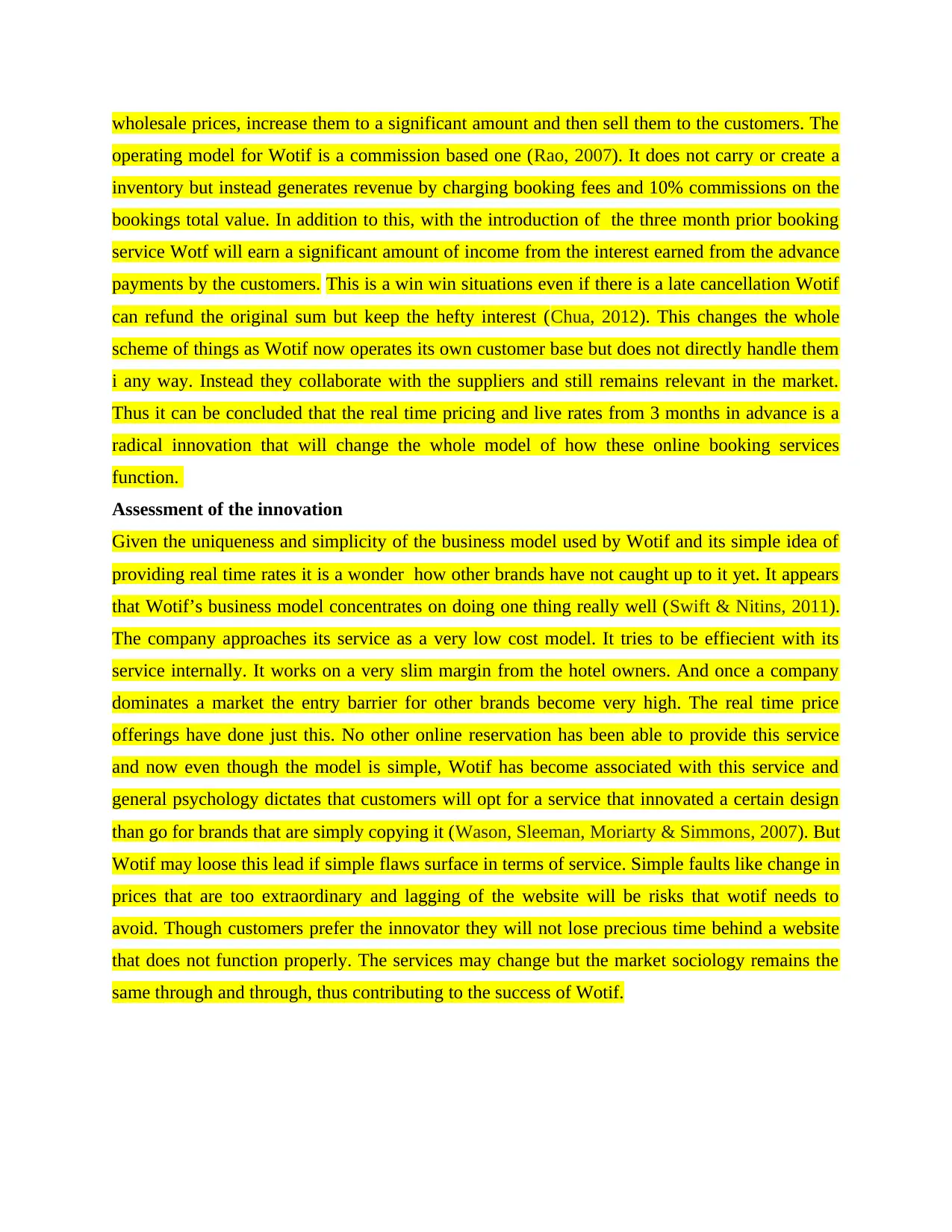
wholesale prices, increase them to a significant amount and then sell them to the customers. The
operating model for Wotif is a commission based one (Rao, 2007). It does not carry or create a
inventory but instead generates revenue by charging booking fees and 10% commissions on the
bookings total value. In addition to this, with the introduction of the three month prior booking
service Wotf will earn a significant amount of income from the interest earned from the advance
payments by the customers. This is a win win situations even if there is a late cancellation Wotif
can refund the original sum but keep the hefty interest (Chua, 2012). This changes the whole
scheme of things as Wotif now operates its own customer base but does not directly handle them
i any way. Instead they collaborate with the suppliers and still remains relevant in the market.
Thus it can be concluded that the real time pricing and live rates from 3 months in advance is a
radical innovation that will change the whole model of how these online booking services
function.
Assessment of the innovation
Given the uniqueness and simplicity of the business model used by Wotif and its simple idea of
providing real time rates it is a wonder how other brands have not caught up to it yet. It appears
that Wotif’s business model concentrates on doing one thing really well (Swift & Nitins, 2011).
The company approaches its service as a very low cost model. It tries to be effiecient with its
service internally. It works on a very slim margin from the hotel owners. And once a company
dominates a market the entry barrier for other brands become very high. The real time price
offerings have done just this. No other online reservation has been able to provide this service
and now even though the model is simple, Wotif has become associated with this service and
general psychology dictates that customers will opt for a service that innovated a certain design
than go for brands that are simply copying it (Wason, Sleeman, Moriarty & Simmons, 2007). But
Wotif may loose this lead if simple flaws surface in terms of service. Simple faults like change in
prices that are too extraordinary and lagging of the website will be risks that wotif needs to
avoid. Though customers prefer the innovator they will not lose precious time behind a website
that does not function properly. The services may change but the market sociology remains the
same through and through, thus contributing to the success of Wotif.
operating model for Wotif is a commission based one (Rao, 2007). It does not carry or create a
inventory but instead generates revenue by charging booking fees and 10% commissions on the
bookings total value. In addition to this, with the introduction of the three month prior booking
service Wotf will earn a significant amount of income from the interest earned from the advance
payments by the customers. This is a win win situations even if there is a late cancellation Wotif
can refund the original sum but keep the hefty interest (Chua, 2012). This changes the whole
scheme of things as Wotif now operates its own customer base but does not directly handle them
i any way. Instead they collaborate with the suppliers and still remains relevant in the market.
Thus it can be concluded that the real time pricing and live rates from 3 months in advance is a
radical innovation that will change the whole model of how these online booking services
function.
Assessment of the innovation
Given the uniqueness and simplicity of the business model used by Wotif and its simple idea of
providing real time rates it is a wonder how other brands have not caught up to it yet. It appears
that Wotif’s business model concentrates on doing one thing really well (Swift & Nitins, 2011).
The company approaches its service as a very low cost model. It tries to be effiecient with its
service internally. It works on a very slim margin from the hotel owners. And once a company
dominates a market the entry barrier for other brands become very high. The real time price
offerings have done just this. No other online reservation has been able to provide this service
and now even though the model is simple, Wotif has become associated with this service and
general psychology dictates that customers will opt for a service that innovated a certain design
than go for brands that are simply copying it (Wason, Sleeman, Moriarty & Simmons, 2007). But
Wotif may loose this lead if simple flaws surface in terms of service. Simple faults like change in
prices that are too extraordinary and lagging of the website will be risks that wotif needs to
avoid. Though customers prefer the innovator they will not lose precious time behind a website
that does not function properly. The services may change but the market sociology remains the
same through and through, thus contributing to the success of Wotif.
⊘ This is a preview!⊘
Do you want full access?
Subscribe today to unlock all pages.

Trusted by 1+ million students worldwide

REPORT PART B - RECOMMENDATIONS
Even though Wotif is dominating the market in its segment and is running profitably the new
feature that has been innovated can use a few improvements and a few recommendations are
provided below.
Though the interface of Wotif is quite simple and user friendly and does not have many
complications and the new mobile application can be used with ease an an AI powered chatbot
can solve every other problems that may rise (Kim & Ha, 2006). Chatbots have become a very
relevant aspect for a lot of companies and integration of his service will help with by solving
real time queries. Chatbots are the new buzz as they can automatically start a conversation
without waiting for he customer to act on their problems. They boost service by letting the guests
now that the company has a caring attitude towards them thus eating a sense of loyalty.
SEO or search engine optimization is another way to ensure an increased amount of traffic the
website. An effective SEO is important as it makes sure that the website is properly set up n
order to be visible on the results pages of a search engine (Zumpe & Madlberger, 2007). SEOS
help by increasing the rankings of the website on different search engines and ultimately aims at
ranking higher up on the results page.
A responsible website with proper CTA or Call To Action needs to be employed. A responsible
website is necessary for proper connectivity an orientation so that the website can be accessed
from a variety of devices without any kind of glitche. Since the new real time price system
involves a lot of intricate and delicate information processing well programmed CTA’s to ensure
a glitch free experience. As Wotif operates on a highly competitive market a lagged website will
make customers look for other options thus creating losses.
CONCLUSION
Wotif is Australia's first Online hotel and tourism service booking website that offers a variety of
services to tourists visiting the country. It operates in a few major cities of the world and offers a
variety of offers. Its new and updated feature of real time pricing that offers rate, 3 months prior
to booking(Murray & Lewis, 2011). This real time management of rates has created new
revolutions in the industry and optimised online bookings in a way that wasn't conceived before.
REFERENCES
Anon, (2018). [online] Available at: https://eprints.qut.edu.au/13359/1/13359.pdf [Accessed 3
Oct. 2018].
Even though Wotif is dominating the market in its segment and is running profitably the new
feature that has been innovated can use a few improvements and a few recommendations are
provided below.
Though the interface of Wotif is quite simple and user friendly and does not have many
complications and the new mobile application can be used with ease an an AI powered chatbot
can solve every other problems that may rise (Kim & Ha, 2006). Chatbots have become a very
relevant aspect for a lot of companies and integration of his service will help with by solving
real time queries. Chatbots are the new buzz as they can automatically start a conversation
without waiting for he customer to act on their problems. They boost service by letting the guests
now that the company has a caring attitude towards them thus eating a sense of loyalty.
SEO or search engine optimization is another way to ensure an increased amount of traffic the
website. An effective SEO is important as it makes sure that the website is properly set up n
order to be visible on the results pages of a search engine (Zumpe & Madlberger, 2007). SEOS
help by increasing the rankings of the website on different search engines and ultimately aims at
ranking higher up on the results page.
A responsible website with proper CTA or Call To Action needs to be employed. A responsible
website is necessary for proper connectivity an orientation so that the website can be accessed
from a variety of devices without any kind of glitche. Since the new real time price system
involves a lot of intricate and delicate information processing well programmed CTA’s to ensure
a glitch free experience. As Wotif operates on a highly competitive market a lagged website will
make customers look for other options thus creating losses.
CONCLUSION
Wotif is Australia's first Online hotel and tourism service booking website that offers a variety of
services to tourists visiting the country. It operates in a few major cities of the world and offers a
variety of offers. Its new and updated feature of real time pricing that offers rate, 3 months prior
to booking(Murray & Lewis, 2011). This real time management of rates has created new
revolutions in the industry and optimised online bookings in a way that wasn't conceived before.
REFERENCES
Anon, (2018). [online] Available at: https://eprints.qut.edu.au/13359/1/13359.pdf [Accessed 3
Oct. 2018].
Paraphrase This Document
Need a fresh take? Get an instant paraphrase of this document with our AI Paraphraser
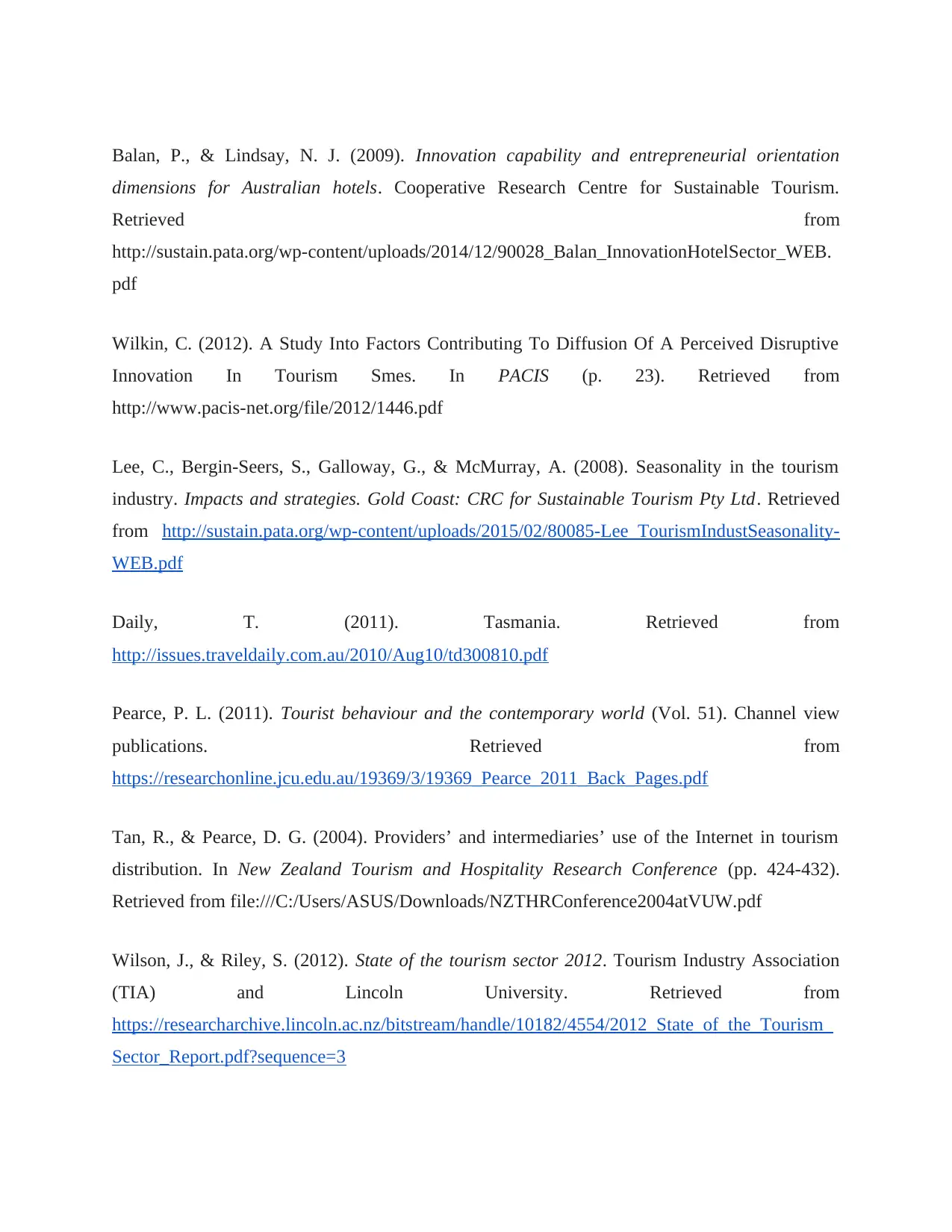
Balan, P., & Lindsay, N. J. (2009). Innovation capability and entrepreneurial orientation
dimensions for Australian hotels. Cooperative Research Centre for Sustainable Tourism.
Retrieved from
http://sustain.pata.org/wp-content/uploads/2014/12/90028_Balan_InnovationHotelSector_WEB.
pdf
Wilkin, C. (2012). A Study Into Factors Contributing To Diffusion Of A Perceived Disruptive
Innovation In Tourism Smes. In PACIS (p. 23). Retrieved from
http://www.pacis-net.org/file/2012/1446.pdf
Lee, C., Bergin-Seers, S., Galloway, G., & McMurray, A. (2008). Seasonality in the tourism
industry. Impacts and strategies. Gold Coast: CRC for Sustainable Tourism Pty Ltd. Retrieved
from http://sustain.pata.org/wp-content/uploads/2015/02/80085-Lee_TourismIndustSeasonality-
WEB.pdf
Daily, T. (2011). Tasmania. Retrieved from
http://issues.traveldaily.com.au/2010/Aug10/td300810.pdf
Pearce, P. L. (2011). Tourist behaviour and the contemporary world (Vol. 51). Channel view
publications. Retrieved from
https://researchonline.jcu.edu.au/19369/3/19369_Pearce_2011_Back_Pages.pdf
Tan, R., & Pearce, D. G. (2004). Providers’ and intermediaries’ use of the Internet in tourism
distribution. In New Zealand Tourism and Hospitality Research Conference (pp. 424-432).
Retrieved from file:///C:/Users/ASUS/Downloads/NZTHRConference2004atVUW.pdf
Wilson, J., & Riley, S. (2012). State of the tourism sector 2012. Tourism Industry Association
(TIA) and Lincoln University. Retrieved from
https://researcharchive.lincoln.ac.nz/bitstream/handle/10182/4554/2012_State_of_the_Tourism_
Sector_Report.pdf?sequence=3
dimensions for Australian hotels. Cooperative Research Centre for Sustainable Tourism.
Retrieved from
http://sustain.pata.org/wp-content/uploads/2014/12/90028_Balan_InnovationHotelSector_WEB.
Wilkin, C. (2012). A Study Into Factors Contributing To Diffusion Of A Perceived Disruptive
Innovation In Tourism Smes. In PACIS (p. 23). Retrieved from
http://www.pacis-net.org/file/2012/1446.pdf
Lee, C., Bergin-Seers, S., Galloway, G., & McMurray, A. (2008). Seasonality in the tourism
industry. Impacts and strategies. Gold Coast: CRC for Sustainable Tourism Pty Ltd. Retrieved
from http://sustain.pata.org/wp-content/uploads/2015/02/80085-Lee_TourismIndustSeasonality-
WEB.pdf
Daily, T. (2011). Tasmania. Retrieved from
http://issues.traveldaily.com.au/2010/Aug10/td300810.pdf
Pearce, P. L. (2011). Tourist behaviour and the contemporary world (Vol. 51). Channel view
publications. Retrieved from
https://researchonline.jcu.edu.au/19369/3/19369_Pearce_2011_Back_Pages.pdf
Tan, R., & Pearce, D. G. (2004). Providers’ and intermediaries’ use of the Internet in tourism
distribution. In New Zealand Tourism and Hospitality Research Conference (pp. 424-432).
Retrieved from file:///C:/Users/ASUS/Downloads/NZTHRConference2004atVUW.pdf
Wilson, J., & Riley, S. (2012). State of the tourism sector 2012. Tourism Industry Association
(TIA) and Lincoln University. Retrieved from
https://researcharchive.lincoln.ac.nz/bitstream/handle/10182/4554/2012_State_of_the_Tourism_
Sector_Report.pdf?sequence=3
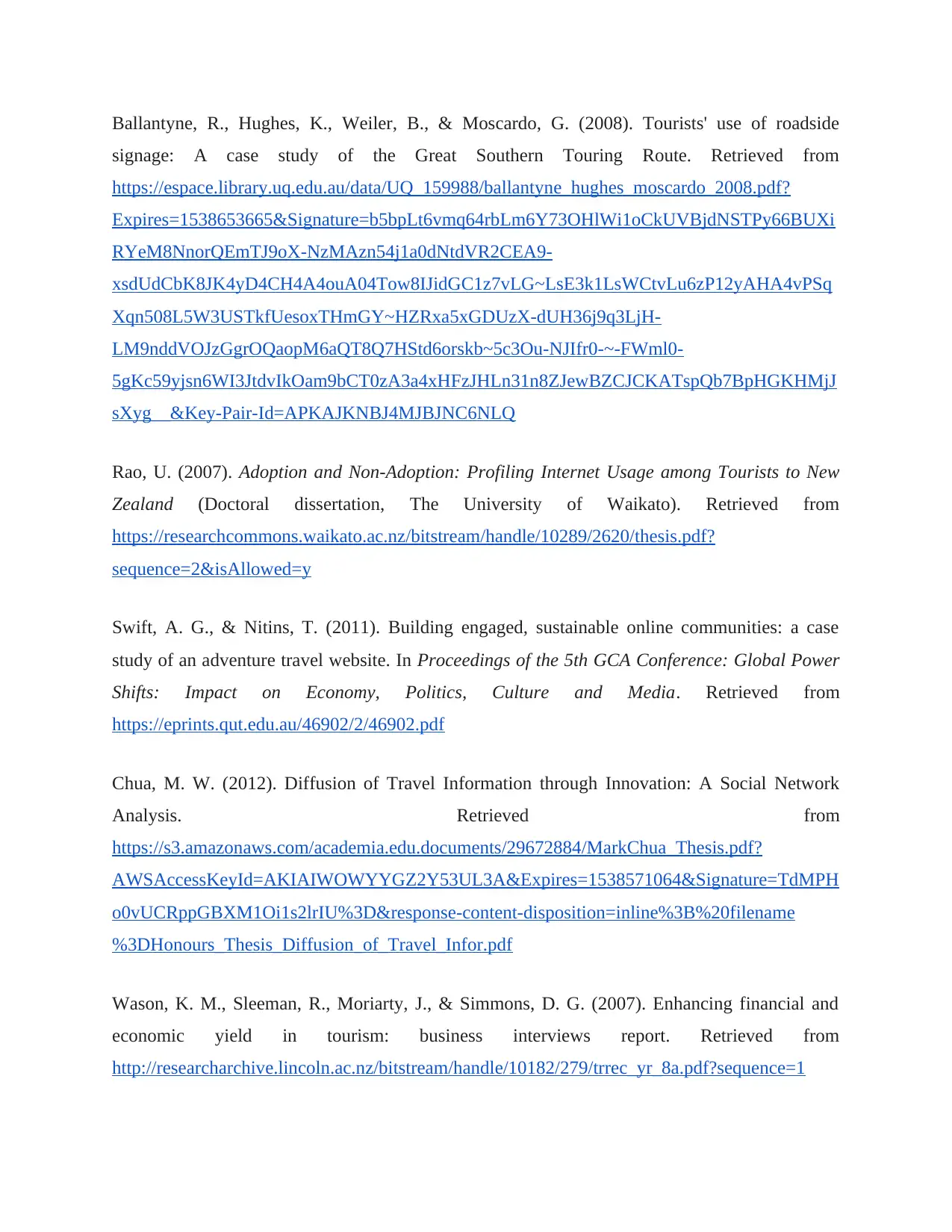
Ballantyne, R., Hughes, K., Weiler, B., & Moscardo, G. (2008). Tourists' use of roadside
signage: A case study of the Great Southern Touring Route. Retrieved from
https://espace.library.uq.edu.au/data/UQ_159988/ballantyne_hughes_moscardo_2008.pdf?
Expires=1538653665&Signature=b5bpLt6vmq64rbLm6Y73OHlWi1oCkUVBjdNSTPy66BUXi
RYeM8NnorQEmTJ9oX-NzMAzn54j1a0dNtdVR2CEA9-
xsdUdCbK8JK4yD4CH4A4ouA04Tow8IJidGC1z7vLG~LsE3k1LsWCtvLu6zP12yAHA4vPSq
Xqn508L5W3USTkfUesoxTHmGY~HZRxa5xGDUzX-dUH36j9q3LjH-
LM9nddVOJzGgrOQaopM6aQT8Q7HStd6orskb~5c3Ou-NJIfr0-~-FWml0-
5gKc59yjsn6WI3JtdvIkOam9bCT0zA3a4xHFzJHLn31n8ZJewBZCJCKATspQb7BpHGKHMjJ
sXyg__&Key-Pair-Id=APKAJKNBJ4MJBJNC6NLQ
Rao, U. (2007). Adoption and Non-Adoption: Profiling Internet Usage among Tourists to New
Zealand (Doctoral dissertation, The University of Waikato). Retrieved from
https://researchcommons.waikato.ac.nz/bitstream/handle/10289/2620/thesis.pdf?
sequence=2&isAllowed=y
Swift, A. G., & Nitins, T. (2011). Building engaged, sustainable online communities: a case
study of an adventure travel website. In Proceedings of the 5th GCA Conference: Global Power
Shifts: Impact on Economy, Politics, Culture and Media. Retrieved from
https://eprints.qut.edu.au/46902/2/46902.pdf
Chua, M. W. (2012). Diffusion of Travel Information through Innovation: A Social Network
Analysis. Retrieved from
https://s3.amazonaws.com/academia.edu.documents/29672884/MarkChua_Thesis.pdf?
AWSAccessKeyId=AKIAIWOWYYGZ2Y53UL3A&Expires=1538571064&Signature=TdMPH
o0vUCRppGBXM1Oi1s2lrIU%3D&response-content-disposition=inline%3B%20filename
%3DHonours_Thesis_Diffusion_of_Travel_Infor.pdf
Wason, K. M., Sleeman, R., Moriarty, J., & Simmons, D. G. (2007). Enhancing financial and
economic yield in tourism: business interviews report. Retrieved from
http://researcharchive.lincoln.ac.nz/bitstream/handle/10182/279/trrec_yr_8a.pdf?sequence=1
signage: A case study of the Great Southern Touring Route. Retrieved from
https://espace.library.uq.edu.au/data/UQ_159988/ballantyne_hughes_moscardo_2008.pdf?
Expires=1538653665&Signature=b5bpLt6vmq64rbLm6Y73OHlWi1oCkUVBjdNSTPy66BUXi
RYeM8NnorQEmTJ9oX-NzMAzn54j1a0dNtdVR2CEA9-
xsdUdCbK8JK4yD4CH4A4ouA04Tow8IJidGC1z7vLG~LsE3k1LsWCtvLu6zP12yAHA4vPSq
Xqn508L5W3USTkfUesoxTHmGY~HZRxa5xGDUzX-dUH36j9q3LjH-
LM9nddVOJzGgrOQaopM6aQT8Q7HStd6orskb~5c3Ou-NJIfr0-~-FWml0-
5gKc59yjsn6WI3JtdvIkOam9bCT0zA3a4xHFzJHLn31n8ZJewBZCJCKATspQb7BpHGKHMjJ
sXyg__&Key-Pair-Id=APKAJKNBJ4MJBJNC6NLQ
Rao, U. (2007). Adoption and Non-Adoption: Profiling Internet Usage among Tourists to New
Zealand (Doctoral dissertation, The University of Waikato). Retrieved from
https://researchcommons.waikato.ac.nz/bitstream/handle/10289/2620/thesis.pdf?
sequence=2&isAllowed=y
Swift, A. G., & Nitins, T. (2011). Building engaged, sustainable online communities: a case
study of an adventure travel website. In Proceedings of the 5th GCA Conference: Global Power
Shifts: Impact on Economy, Politics, Culture and Media. Retrieved from
https://eprints.qut.edu.au/46902/2/46902.pdf
Chua, M. W. (2012). Diffusion of Travel Information through Innovation: A Social Network
Analysis. Retrieved from
https://s3.amazonaws.com/academia.edu.documents/29672884/MarkChua_Thesis.pdf?
AWSAccessKeyId=AKIAIWOWYYGZ2Y53UL3A&Expires=1538571064&Signature=TdMPH
o0vUCRppGBXM1Oi1s2lrIU%3D&response-content-disposition=inline%3B%20filename
%3DHonours_Thesis_Diffusion_of_Travel_Infor.pdf
Wason, K. M., Sleeman, R., Moriarty, J., & Simmons, D. G. (2007). Enhancing financial and
economic yield in tourism: business interviews report. Retrieved from
http://researcharchive.lincoln.ac.nz/bitstream/handle/10182/279/trrec_yr_8a.pdf?sequence=1
⊘ This is a preview!⊘
Do you want full access?
Subscribe today to unlock all pages.

Trusted by 1+ million students worldwide

Zumpe, S., & Madlberger, M. (2007). A transaction-based framework for business models in
electronic commerce. PACIS 2007 Proceedings, 15. Retrieved from
http://citeseerx.ist.psu.edu/viewdoc/download?doi=10.1.1.231.3462&rep=rep1&type=pdf
Kim, Y. B., & Ha, S. W. (2006). Performance and strategic changes of SMEs in the Korean
electronic parts industry 1990-2001: A dynamic strategic group approach. In 2006 ICSB World
Conference (pp. 0-0). International Council for Small Business (ICSB). Retrieved from
http://koasas.kaist.ac.kr/bitstream/10203/6839/1/2006-103.pdf
Murray, C., & Lewis, I. M. (2011). Is there an App for that?: Social media uses for road safety.
Retrieved from
https://eprints.qut.edu.au/45848/1/MURRAY_ACRS_National_Conference_Full_Paper.pdf
electronic commerce. PACIS 2007 Proceedings, 15. Retrieved from
http://citeseerx.ist.psu.edu/viewdoc/download?doi=10.1.1.231.3462&rep=rep1&type=pdf
Kim, Y. B., & Ha, S. W. (2006). Performance and strategic changes of SMEs in the Korean
electronic parts industry 1990-2001: A dynamic strategic group approach. In 2006 ICSB World
Conference (pp. 0-0). International Council for Small Business (ICSB). Retrieved from
http://koasas.kaist.ac.kr/bitstream/10203/6839/1/2006-103.pdf
Murray, C., & Lewis, I. M. (2011). Is there an App for that?: Social media uses for road safety.
Retrieved from
https://eprints.qut.edu.au/45848/1/MURRAY_ACRS_National_Conference_Full_Paper.pdf
1 out of 10
Related Documents
Your All-in-One AI-Powered Toolkit for Academic Success.
+13062052269
info@desklib.com
Available 24*7 on WhatsApp / Email
![[object Object]](/_next/static/media/star-bottom.7253800d.svg)
Unlock your academic potential
© 2024 | Zucol Services PVT LTD | All rights reserved.



